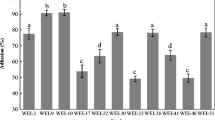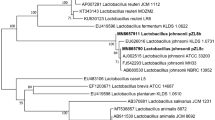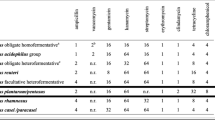Abstract
The present study evaluates the probiotic properties of three Lactobacillus plantarum strains MJM60319, MJM60298, and MJM60399 possessing antimicrobial activity against animal enteric pathogens. The three strains did not show bioamine production, mucinolytic and hemolytic activity and were susceptible to common antibiotics. The L. plantarum strains survived well in the simulated orogastrointestinal transit condition and showed adherence to Caco-2 cells in vitro. The L. plantarum strains showed strong antimicrobial activity against enterotoxigenic Escherichia coli, Shiga toxin-producing E. coli, Salmonella enterica subsp. enterica serovar Typhimurium, Choleraesuis and Gallinarum compared to the commercial probiotic strain Lactobacillus rhamnosus GG. The mechanism of antimicrobial activity of the L. plantarum strains appeared to be by the production of lactic acid. Furthermore, the L. plantarum strains tolerated freeze-drying and maintained higher viability in the presence of cryoprotectants than without cryoprotectants. Finally, the three L. plantarum strains tolerated NaCl up to 8% and maintained >60% growth. These characteristics of the three L. plantarum strains indicate that they could be applied as animal probiotic after appropriate in vivo studies.






Similar content being viewed by others
References
Garmendia J, Frankel G, Crepin VF (2005) Enteropathogenic and enterohemorrhagic Escherichia coli infections: translocation, translocation, translocation. Infect Immun 73:2573–2585. doi:10.1128/IAI.73.5.2573-2585.2005
Coburn B, Grassl GA, Finlay BB (2007) Salmonella, the host and disease: a brief review. Immunol Cell Biol 85:112–118. doi:10.1038/sj.icb.7100007
Naqid IA, Owen JP, Maddison BC, Gardner DS, Foster N, Tchórzewska MA, La Ragione RM, Gough KC (2015) Prebiotic and probiotic agents enhance antibody-based immune responses to Salmonella Typhimurium infection in pigs. Anim Feed Sci Technol 201:57–65. doi:10.1016/j.anifeedsci.2014.12.005
Van Immerseel F, Studholme DJ, Eeckhaut V, Heyndrickx M, Dewulf J, Dewaele I, Van Hoorebeke S, Haesebrouck F, Van Meirhaeghe H, Ducatelle R, Paszkiewicz K, Titball RW (2013) Salmonella Gallinarum field isolates from laying hens are related to the vaccine strain SG9R. Vaccine 31:4940–4945. doi:10.1016/j.vaccine.2013.08.033
Kwon YK, Kim A, Kang MS, Her M, Jung BY, Lee KM, Jeong W, An BK, Kwon JH (2010) Prevalence and characterization of Salmonella Gallinarum in the chicken in Korea during 2000 to 2008. Poult Sci 89:236–242. doi:10.3382/ps.2009-00420
Steinmuller N, Demma L, Bender JB, Eidson M, Angulo FJ (2006) Outbreaks of enteric disease associated with animal contact: not just a foodborne problem anymore. Clin Infect Dis 43:1596–1602
Osei Sekyere J (2014) Antibiotic types and handling practices in disease management among pig farms in Ashanti region, Ghana. J Vet Med 2014:531952. doi:10.1155/2014/531952
Tellez G, Pixley C, Wolfenden RE, Layton SL, Hargis BM (2012) Probiotics/direct fed microbials for Salmonella control in poultry. Food Res Int 45:628–633. doi:10.1016/j.foodres.2011.03.047
FAO/WHO (2001) Expert consultation on health and nutritional properties of probiotics in food including powder milk with live lactic acid bacteria. World Health Organization [online]. http://www.fao.org/3/a-a0512e.pdf. Accessed 01 June 2016
Bomba A, Kravjansk I, Kagtel R, Herich R, Juhasova Z, Cizek M, Kapitancik B (1996) Inhibitory effects of Lactobacillus casei upon the adhesion of enterotoxigenic Escherichia coli K99 to the intestinal mucosa in gnotobiotic lambs. Small Rumin Res 23:199–206
Collado MC, Grzeskowiak L, Salminen S (2007) Probiotic strains and their combination inhibit in vitro adhesion of pathogens to pig intestinal mucosa. Curr Microbiol 55:260–265. doi:10.1007/s00284-007-0144-8
Slizewska K, Piotrowska M (2014) Reduction of ochratoxin A in chicken feed using probiotic. Ann Agric Environ Med 21:676–680. doi:10.5604/12321966.1129913
Zimmermann JA, Rossler E, Blajman JE, Romero-Scharpen A, Astesana DM, Olivero CR, Berisvil AP, Signorini ML, Zbrun MV, Frizzo LS, Soto LP (2016) Effects of probiotics in swines growth performance: a meta-analysis of randomised controlled trials. Anim Feed Sci Technol 219:280–293
Blajman JE, Frizzo LS, Zbrun MV, Astesana DM, Fusari ML, Soto LP, Rosmini MR, Signorini ML (2014) Probiotics and broiler growth performance: a meta-analysis of randomised controlled trials. Br Poult Sci 55:483–494. doi:10.1080/00071668.2014.931930
Bover-Cid S, Holzapfel WH (1999) Improved screening procedure for biogenic amine production by lactic acid bacteria. Int J Food Microbiol 53:33–41
Zhou JS, Gopal PK, Gill HS (2001) Potential probiotic lactic acid bacteria Lactobacillus rhamnosus (HN001), Lactobacillus acidophilus (HN017) and Bifidobacterium lactis (HN019) do not degrade gastric mucin in vitro. Int J Food Microbiol 63:81–90
Wiegand I, Hilpert K, Hancock RE (2008) Agar and broth dilution methods to determine the minimal inhibitory concentration (MIC) of antimicrobial substances. Nat Protoc 3:163–175. doi:10.1038/nprot.2007.521nprot.2007.521
Damodharan K, Lee YS, Palaniyandi SA, Yang SH, Suh JW (2015) Preliminary probiotic and technological characterization of Pediococcus pentosaceus strain KID7 and in vivo assessment of its cholesterol-lowering activity. Front Microbiol 6:768. doi:10.3389/fmicb.2015.00768
Tamura K, Stecher G, Peterson D, Filipski A, Kumar S (2013) MEGA6: molecular evolutionary genetics analysis version 6.0. Mol Biol Evol 30:2725–2729
De Vuyst L, Camu N, De Winter T, Vandemeulebroecke K, Van de Perre V, Vancanneyt M, De Vos P, Cleenwerck I (2008) Validation of the (GTG)(5)-rep-PCR fingerprinting technique for rapid classification and identification of acetic acid bacteria, with a focus on isolates from Ghanaian fermented cocoa beans. Int J Food Microbiol 125:79–90. doi:10.1016/j.ijfoodmicro.2007.02.030
Bove P, Gallone A, Russo P, Capozzi V, Albenzio M, Spano G, Fiocco D (2012) Probiotic features of Lactobacillus plantarum mutant strains. Appl Microbiol Biotechnol 96:431–441. doi:10.1007/s00253-012-4031-2
Marteau P, Minekus M, Havenaar R, Huis in’t Veild JH (1997) Survival of lactic acid bacteria in a dynamic model of the stomach and small intestine: validation and the effects of bile. J Diary Sci 80:1031–1037
Tuo Y, Yu H, Ai L, Wu Z, Guo B, Chen W (2013) Aggregation and adhesion properties of 22 Lactobacillus strains. J Dairy Sci 96:4252–4257. doi:10.3168/jds.2013-6547
EFSA (2012) Guidance on the assessment of bacterial susceptibility to antimicrobials of human and veterinary importance. EFSA J 10:2740. doi:10.2903/j.efsa.2012.2740
Wang DS, Zhang RY, Zhu WY, Mao SY (2013) Effects of subacute ruminal acidosis challenges on fermentation and biogenic amines in the rumen of dairy cows. Livest Sci 155:262–272. doi:10.1016/j.livsci.2013.05.026
Canibe N, Virtanen E, Jensen BB (2007) Effect of acid addition to pig liquid feed on its microbial and nutritional characteristics. Livest Sci 108:202–205. doi:10.1016/j.livsci.2007.01.094
Kiarie E, Slominski BA, Nyachoti CM (2009) Tissue fatty acid profiles, plasma biochemical characteristics and cecal biogenic amines in piglets fed diets containing flaxseed and carbohydrase enzymes. Livest Sci 121:1–6. doi:10.1016/j.livsci.2008.05.009
Roberton AM, Corfield AP (1999) Mucin degradation and its significance in inflammatory conditions of the gastrointestinal tract. In: Tannock GW (ed) Medical importance of the normal microflora. Springer, Dordrecht, pp 222–261. doi:10.1007/978-1-4757-3021-0
Colina A-R, Aumont F, Deslauriers N, Belhumeur P, Repentigny LD (1996) Evidence for degradation of gastrointestinal mucin by Candida albicans secretory aspartyl proteinase. Infect Immun 64:4514–4519
Pringsulaka O, Rueangyotchanthana K, Suwannasai N, Watanapokasin R, Amnueysit P, Sunthornthummas S, Sukkhum S, Sarawaneeyaruk S, Rangsiruji A (2015) In vitro screening of lactic acid bacteria for multi-strain probiotics. Livest Sci 174:66–73. doi:10.1016/j.livsci.2015.01.016
Šušković J, Kos B, Beganović J, Pavunc AL, Habjanič K, Matošić S (2010) Antimicrobial activity—the most important property of probiotic and starter lactic acid bacteria. Food Technol Biotechnol 48:296–307
Raftari M, Jalilian FA, Abdulamir AS, Son R, Sekawi Z, Fatimah AB (2009) Effect of organic acids on Escherichia coli O157:H7 and Staphylococcus aureus contaminated meat. Open Microbiol J 3:121–127
Hussain G, Rahman A, Hussain T, Uddin S, Ali T (2015) Citric and lactic acid effects on the growth inhibition of E. coli and S. typhymurium on beef during storage. Sarhad J Agric 31:183–190. doi:10.17582/journal.sja/2015/31.3.183.190
Ross RP, Desmond C, Fitzgerald GF, Stanton C (2005) Overcoming the technological hurdles in the development of probiotic foods. J Appl Microbiol 98:1410–1417. doi:10.1111/j.1365-2672.2005.02654.x
Cai Y, Ohmomo S, Ogawa M, Kumai S (1997) Effect of NaCl-tolerant lactic acid bacteria and NaCl on the fermentation characteristics and aerobic stability of silage. J Appl Microbiol 83:307–313
Carvalho AS, Silva J, Ho P, Teixeira P, Malcata FX, Gibbs P (2004) Effects of various sugars added to growth and drying media upon thermotolerance and survival throughout storage of freeze-dried Lactobacillus delbrueckii ssp. bulgaricus. Biotechnol Prog 20:248–254
Acknowledgements
This work was carried out with the support of “Cooperative Research Program for Agriculture Science and Technology Development (Project No. PJ01133402)” Rural Development Administration, Republic of Korea.
Author information
Authors and Affiliations
Corresponding authors
Rights and permissions
About this article
Cite this article
Palaniyandi, S.A., Damodharan, K., Suh, JW. et al. In Vitro Characterization of Lactobacillus plantarum Strains with Inhibitory Activity on Enteropathogens for Use as Potential Animal Probiotics. Indian J Microbiol 57, 201–210 (2017). https://doi.org/10.1007/s12088-017-0646-4
Received:
Accepted:
Published:
Issue Date:
DOI: https://doi.org/10.1007/s12088-017-0646-4




